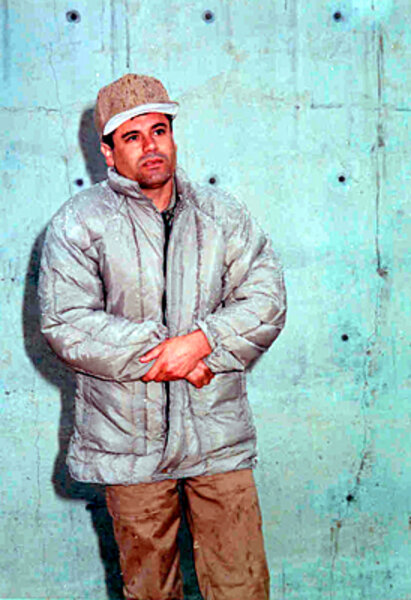Mexico isn't in cahoots with Sinaloa drug cartel, says government
Loading...
Joaquin Guzman, alias “El Chapo,” heads the Sinaloa Cartel, Mexico’s biggest drug trafficking organization, and is now the most wanted man in Mexico, if not the world. He has been on the run since escaping prison in 2001, and was recently described by an official from the US Drug Enforcement Administration as the biggest drug trafficker in history.
Mr. Guzman’s decade of liberty is an ongoing embarrassment to the Mexican government, especially with the emergence of claims over the years that the drug lord was living openly in the mountains of the Sierra Madre. There are stories about him marrying in a public ceremony in a local village, zooming through the region in a convoy of cars, and going out to eat in restaurants accompanied by his entourage.
Meanwhile, there are suspicions that the government is focusing on pursuing members of other drug-trafficking organizations at the expense of targeting the Sinaloa Cartel. An investigation by the US radio station NPR in 2010 found that the number of Sinaloa members captured is disproportionately low, relative to those arrested from other criminal groups.
All this, together with the rising fortunes of the Sinaloa Cartel, has led to suspicions that law enforcement may be on Guzman’s side, perhaps working to eliminate the Sinaloa Cartel's rivals at the expense of targeting Sinaloan operatives, with "El Chapo's" unofficial blessing.
Even the US government has referenced such doubts; a cable sent by U.S. embassy staff in January 2009 and released by WikiLeaks referred to the “widely held” view that the army was allowing the Sinaloa and Juarez Cartels fight it out in Cuidad Juarez. The cable also noted that many thought the government would prefer Sinaloa to win, and that the army and federal police “rarely” had direct confrontations with the drug gangs.
In one previous "myth busting" blog post, the government blamed previous administrations for their "inaction and tolerance" towards crime. The question is whether the administration of Mexican President Felipe Calderon deserves suspicion that the Sinaloa Cartel is now facing similar "inaction and tolerance" from the authorities.
It is true that the group probably enjoys close relationships with powerful elements in Mexico’s law enforcement, perhaps more so than its rivals. However, rather than being evidence of a conspiracy, this is more likely a product of the Sinaloa Cartel's longevity and wealth, as well as the fact that it favors a more quiet, low-key approach than groups like the Zetas, who are more prepared to use violence to gain authority.
An important distinction should be made between Mr. Calderon’s administration and elements in the army, police, and local government. Clearly it would be impossible for such a famous fugitive to remain at large for so long within his own country without support from some sectors of the security forces. There are many areas of the county where officials, even at the highest levels, are in the pockets of traffickers such as the Sinaloans, but this does not mean that Calderon’s government is backing the Sinaloa Cartel as a matter of policy. This is more a sign of the federal government’s lack of control over their forces than of their complicity with Guzman.
It's also possible that the Mexican government is simply attacking the groups strategically, going after the weakest first and leaving Sinaloa until last. Another factor is that the Sinaloans are simply using corruption rather than violence as their preferred business strategy, in contrast to the Zetas, known for burying scores of people in mass graves. This means by default, the Sinaloa Cartel must attract less attention from authorities, who must prioritize targeting the cartels who use brutal, attention-grabbing tactics that are most disruptive to public security.
US law enforcement may have its own part to play in allowing Guzman to remain at liberty. A group of hackers recently released documents which seemingly showed that in 2009 US authorities had failed to alert Mexican law enforcement about a tip-off that the Sinaloa head and his associates had been gathered at a ranch near the Arizona border. However, this could itself be evidence that the US authorities do not sufficiently trust Mexican forces to feed them information about Guzman.
Recent reports have also placed Guzman outside of Mexico, suggesting that it is increasingly uncomfortable for him to operate in his home country. One unsubstantiated report claimed that the kingpin had moved many of his operations to Argentina, and had been living there for some months until March 2011. More recently, and perhaps more credibly, Guatemalan President Alvaro Colom said that he had repeatedly received intelligence reports saying that Guzman was in Guatemala, and that he was thought to move between Guatemala and Honduras.
In a sign of how deep Guzman’s influence goes, or how far people believe in the drug lord’s boundless ability to corrupt, even Mr. Colom appeared to feel the need to emphasize his government is not protecting the Sinaloa leader (Guzman was arrested in Guatemala in 1993). “We are behind him,” said the president, “and if we have not captured him it is simply because the information was incomplete or not timely.”
--- Hannah Stone is a writer for Insight – Organized Crime in the Americas, which provides research, analysis, and investigation of the criminal world throughout the region. Find all of her research here.





